Cameras On Board The Titanic Captured What Those Final Days Were Really Like
Almost everyone knows about the tragic story about the sinking of the world's largest "unsinkable" ship. The legend of the RMS Titanic has lived on in books, television, and of course, everyone's favorite James Cameron 1997 blockbuster film. The facts and history of the Titanic also live on in photos from onboard the ship. Photography at the time was expensive and rare, but what better place to have a photographer than the world's first luxury ocean liner?
From the first-class cabins fit for a queen to a rare view of life in the boiler rooms, see the tragic photos of what the Titanic looks like today, and then step into the past to see what life was really like onboard the RMS Titanic.
The Titanic We All Know
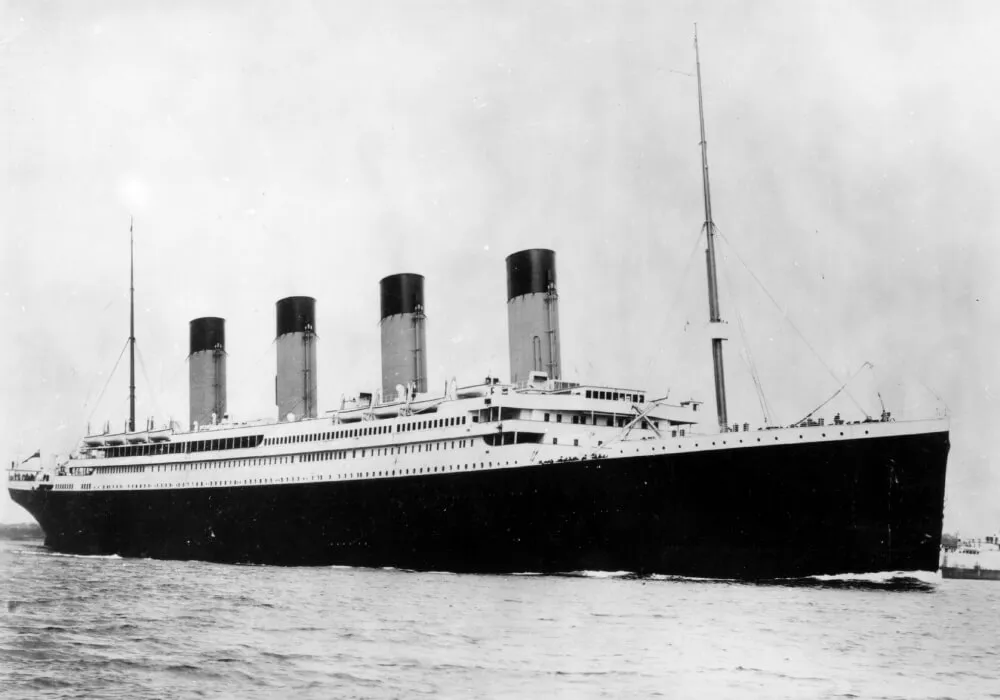
The name Titanic came from Greek mythology and literally meant "gigantic." This photo makes it clear just how large it was. The Titanic set sail on April 10, 1912, with more than 2000 people on board.
The building of the ship had been well-publicized. The $7,500,000 price tag also helped keep people talking about it. The size, technical innovations, and impressive features on board the ocean liner made everyone in the world buzz with excitement.
The Discovery Which Sparked Our Curiosity

Sadly, the Titanic sank only four days into its maiden voyage after colliding with an iceberg. It wasn't until the 1980s that people were able to successfully dive and explore the wreckage. This photo taken in the '90s shows a ship slowly deteriorating. It served as inspiration for director James Cameron to produce the blockbuster hit Titanic.
Explorations of the wreck eventually stopped but in 2019, after 14 years untouched, divers returned to the Titanic to see if it is still intact.
New Photos Reveal Just How Much The Ship Has Decayed

In late August 2019, a team of international deep-sea explorers observed and documented the decaying process of the Titanic. The team performed five organized dives in which they discovered a shocking rate of decay affecting the iconic ship.
In an interview with BBC, Titanic historian Parks Stephenson said, "The captain's bathtub is a favorite image among Titanic enthusiasts, and that’s now gone. That whole deck house on that side is collapsing, taking with it the staterooms. And that deterioration is going to continue advancing."
The Lounge Roof And Bow Are The Next To Go

While it saddens many to see the ship decaying away at the bottom of the ocean, Titanic historian Parks Stephenson says, "Titanic is returning to nature." These stunning photos show what the ship looks like today, but it's nothing in comparison to how it looked on its maiden voyage.
We all know the romantic story of Jack and Rose but what was it really like to be on the ship? Being onboard the RMS Titanic was a luxury if you were first-class, but a horrifying experience for the third-class. Read on to see what life was like for the 325 first-class, 284 second-class, and the 709 third-class passengers.
The Ship Had Saleswomen On Board

Here, an Irish woman sells lace on board a second-class deck. There was no protocol on the Titanic that said your luggage couldn't be full of goods to sell on board. For many people who resorted to a life of sales, buying a ticket on the Titanic would have been a gamble they were willing to take.
This woman was likely hoping that the profits made on the trip would help fund a new life for her in America.
The Titanic's Captain Before The Ship Launch
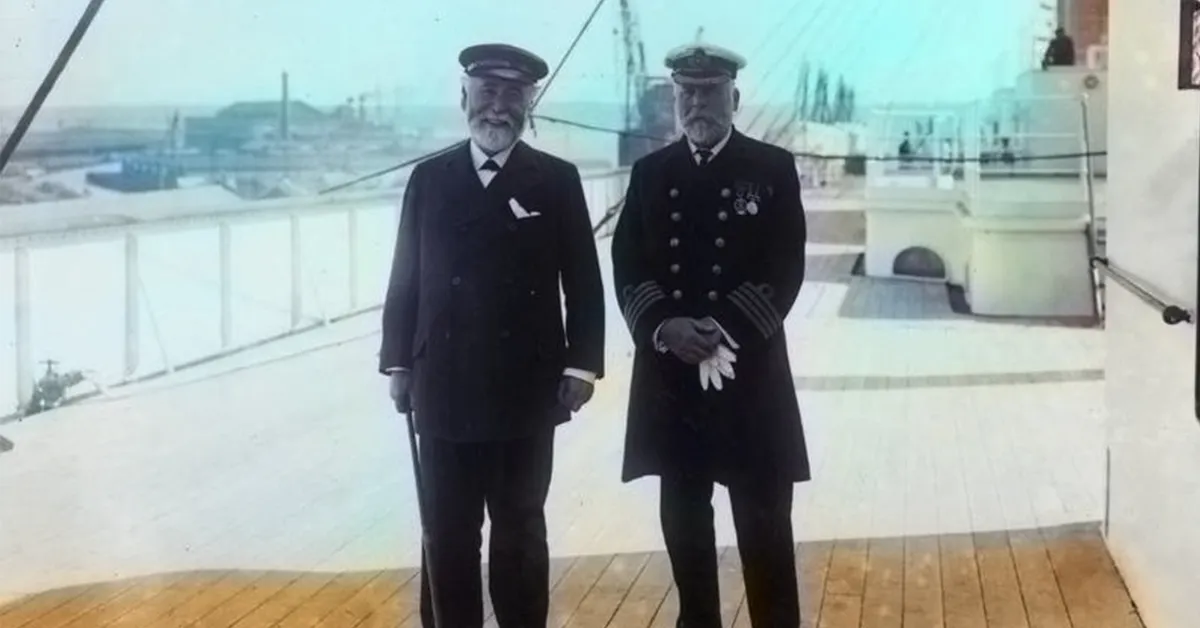
Pictured here in June 1911, one year before the Titanic would set sail, is Captain Edward John Smith and Lord James Pirrie, Chairman of the Belfast Shipyard. Smith served as the captain of many White Star Line ships and felt honored to be chosen for the Titanic's maiden voyage.
Smith was asleep in his cabin when the Titanic struck the iceberg. While he did everything possible to get people off the ship, there are conflicting reports that he either drowned or committed suicide with a pistol.
A Rare Image Of What The Boiler Rooms Were Like

Here you can see what the reality was like for those who worked in the Titanic's boiler rooms. Keeping the ship moving was a 24/7 job that was dirty and harsh. There were six boiler rooms that held 29 boilers. 179 men worked round the clock to fuel the boilers with 600 tonnes of coal every single day.
These workers were paid well, but none escaped. The boiler rooms were some of the first to be flooded when the ship hit an iceberg.
The Iconic Staircase
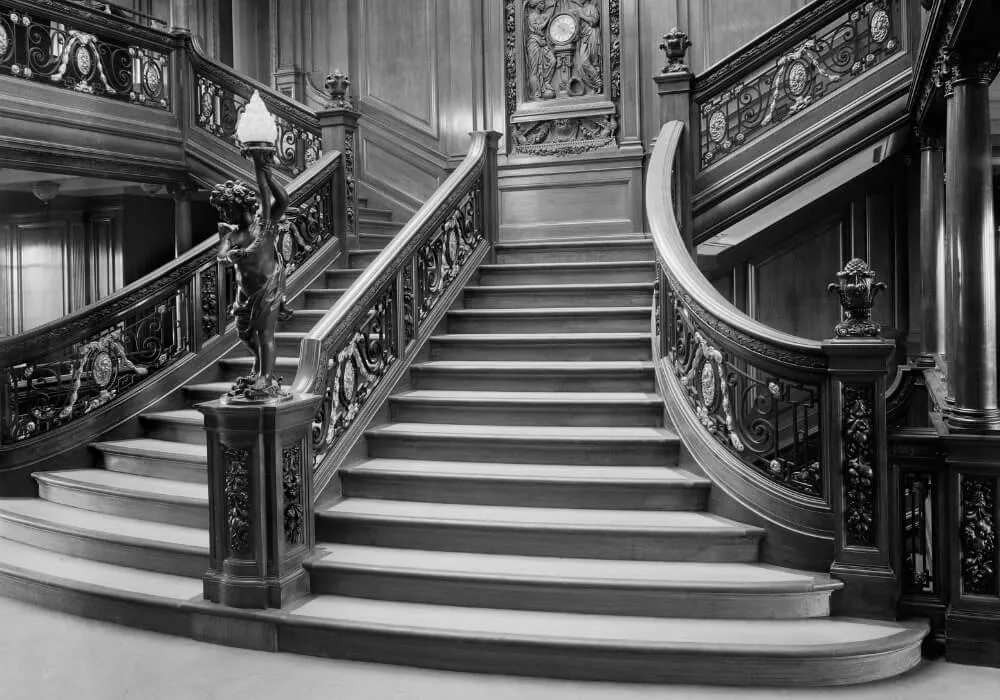
It's understandable if you think this staircase looks straight out of the film Titanic. The Grand Staircase was the main throughway between multiple decks and has become one of the most recognizable parts of the ship.
This portion of the staircase was only used by the first-class passengers, but even third-class passengers could get a rare glimpse of it. The stairway was meant to make people stop and stare, as the builders intended it to be the 'pièce de resistance' of the ship.
The Music Truly Never Stopped

The old legend that the band never stopped playing while the RMS Titanic sank is very much true. Knowing they'd eventually perish makes it even more horrifying to see the band playing on a normal evening.
Little did these musicians know that they would play until their last breath in just a few days. The eight-member band was led by Wallace Hartley, and it was his choice to play the night away to keep the passengers calm.
An Old Timey Gym To Help You Get Your Sea Legs
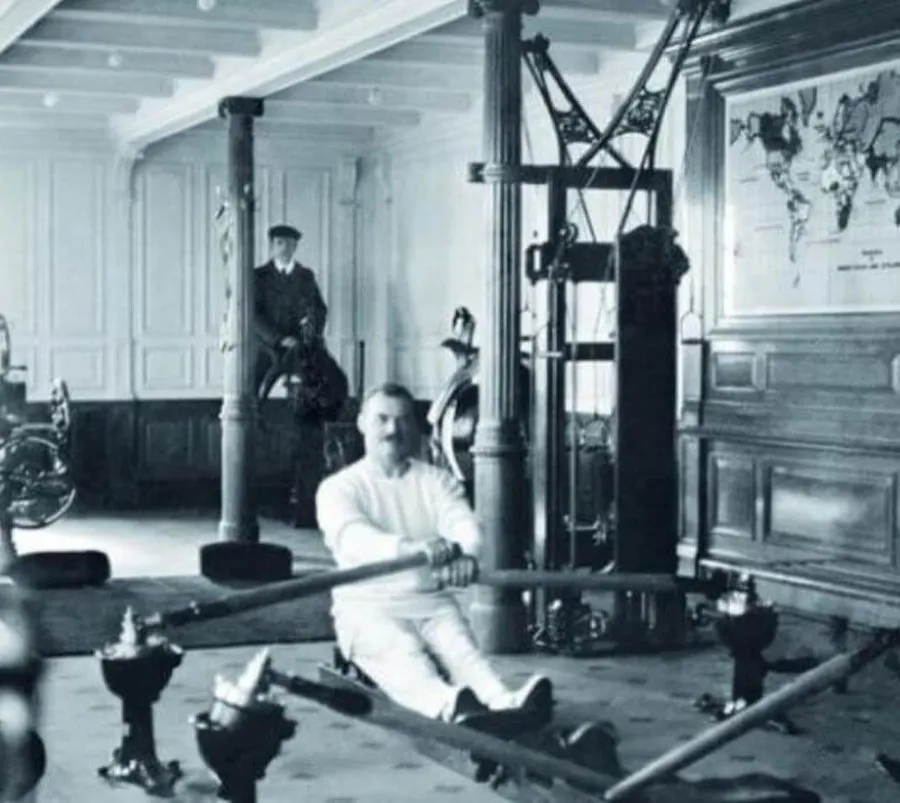
It might be shocking to see that among the many other features on the Titanic, it also had a small gymnasium with dated fitness equipment. The gymnasium included an electric camel, electric horse, and cycling machines. Unsurprisingly, only the first-class passengers could use the innovative facility.
The gym was open for ladies from 9 am to noon, and for men between 2 and 6 pm. It's a good thing this guy was practicing his rowing skills because little did he know, he would soon need them.
They Had A Deck Devoted Entirely To Games

A lot of what many people know about the Titanic involves the entertainment for adults, but what about the kids? 126 children were on board the Titanic and sadly, 60 did not survive the sinking. A majority of those were in the second and third class.
This little boy here is see passing time by playing shuffleboard on the Promenade Deck. First-class children could also pass the time at the gymnasium between 1 and 3 pm.
A First-Class Lavish Lounge
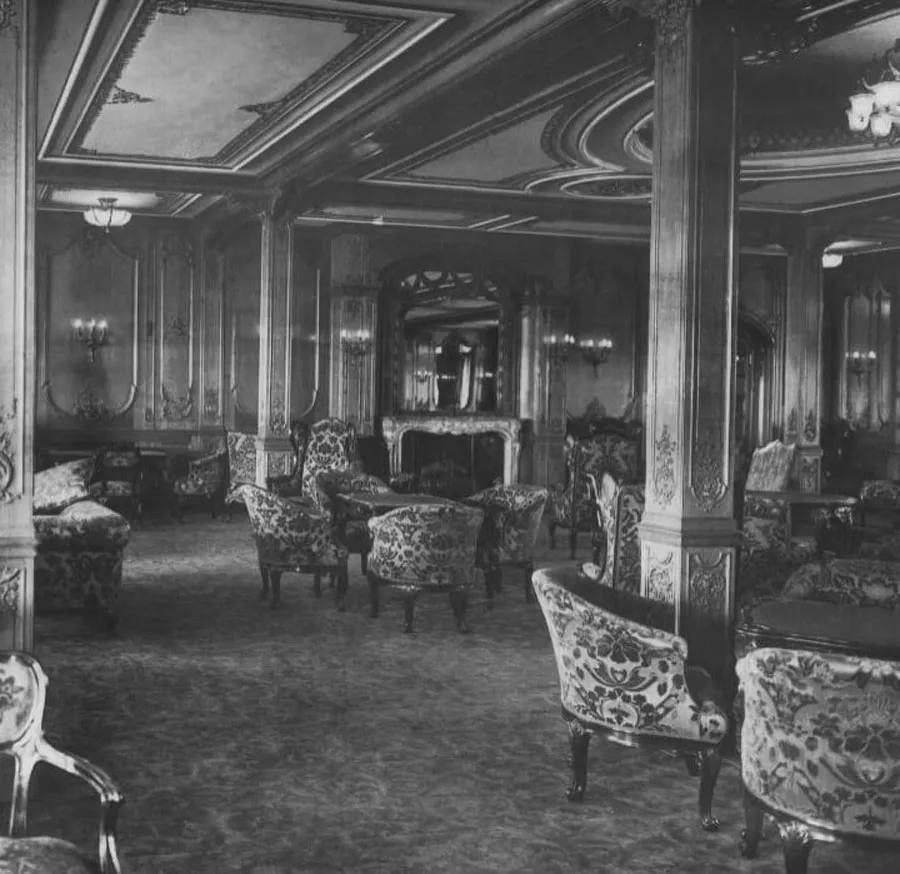
Here you can see just how outlandish and ornate the decor was in the first-class lounge. Located on Deck A, this smoking and social lounge would have been a hot spot for lunch, card games, and even business affairs.
A first-class ticket would have cost $1700 today, so they definitely got their money's worth. The lounge was styled to look like the Palace of Versailles in France. It was in this lounge that the band began playing their final notes.
There Were Two Separate Barber Shops On Board
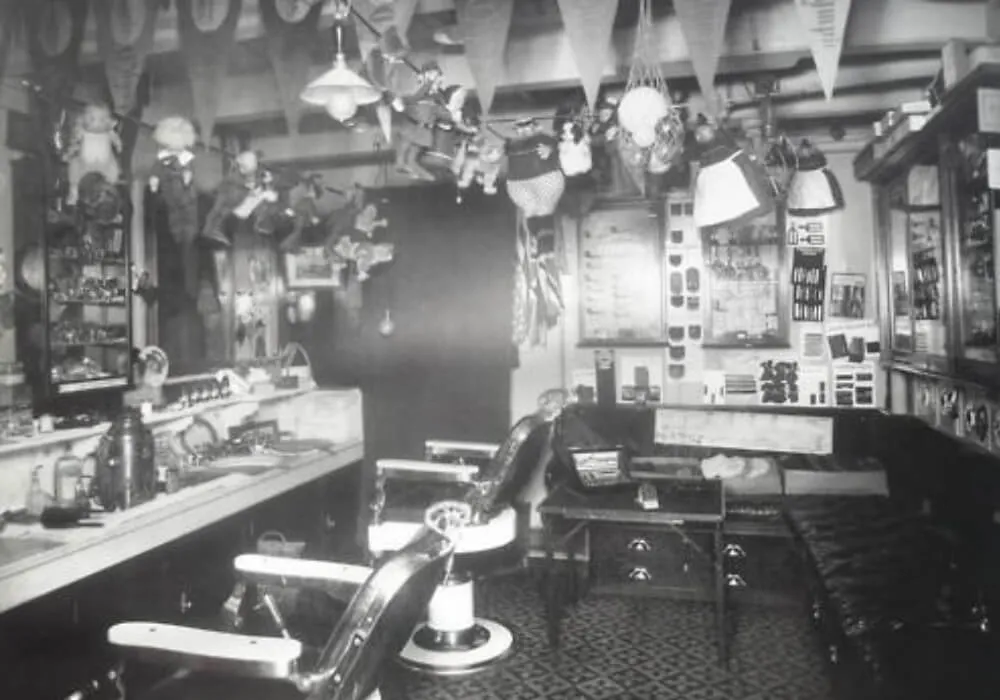
The Titanic boasted not one, but two, barber shops on board. These barbers mostly provided daily trimmings to men's facial hair. One barber was solely for first-class passengers, while the other barber was for second-class. If you were third-class, you would have to go the entire trip without a trim.
The barber shop was also kind of like a modern-day souvenir shop. You can see dolls, hats, ribbons, trinkets, and tobacco hanging up on the walls for sale.
Café Parisien Was The Go-To Spot For Tea Time

If you didn't want to spend your days at the indoor lounge, you could drink and socialize at the Café Parisien, which overlooked the Atlantic Ocean. It was the first of its kind on an ocean liner. The Café was most popular with the younger first-class crowd instead of a stuffy parlor.
The Café Parisien was the first restaurant of its kind on an ocean liner and served food like oysters, salmon, roast duckling, and vanilla éclairs.
A First-Class Cabin Was Like A Dream

This glimpse into the luxurious first-class sleeping cabin is a nicer bedroom than most other passengers could ever dream of. One set of staterooms were so elite that they were connected by a private deck. It was these ultra-private staterooms which were recreated for the film Titanic.
The first-class cabins were all located on the B Deck. Sadly, the B Deck is where most of the crew and passengers who could not escape the ship would take their last stand as it sank.
Second-Class Cabins Were Comfortable Enough

The bunks, private bathrooms, and a seating area in the second-class cabins were more than enough for many. There were even select second-class cabins that could double as first-class cabins, which meant they were more lavish.
A cabin like this could have been as high up at the C Deck, and as low down as the E Deck. Many people think that second-class passengers had it better than third-class, but many did not escape death either.
Third-Class Cabins Were Hardly Inviting
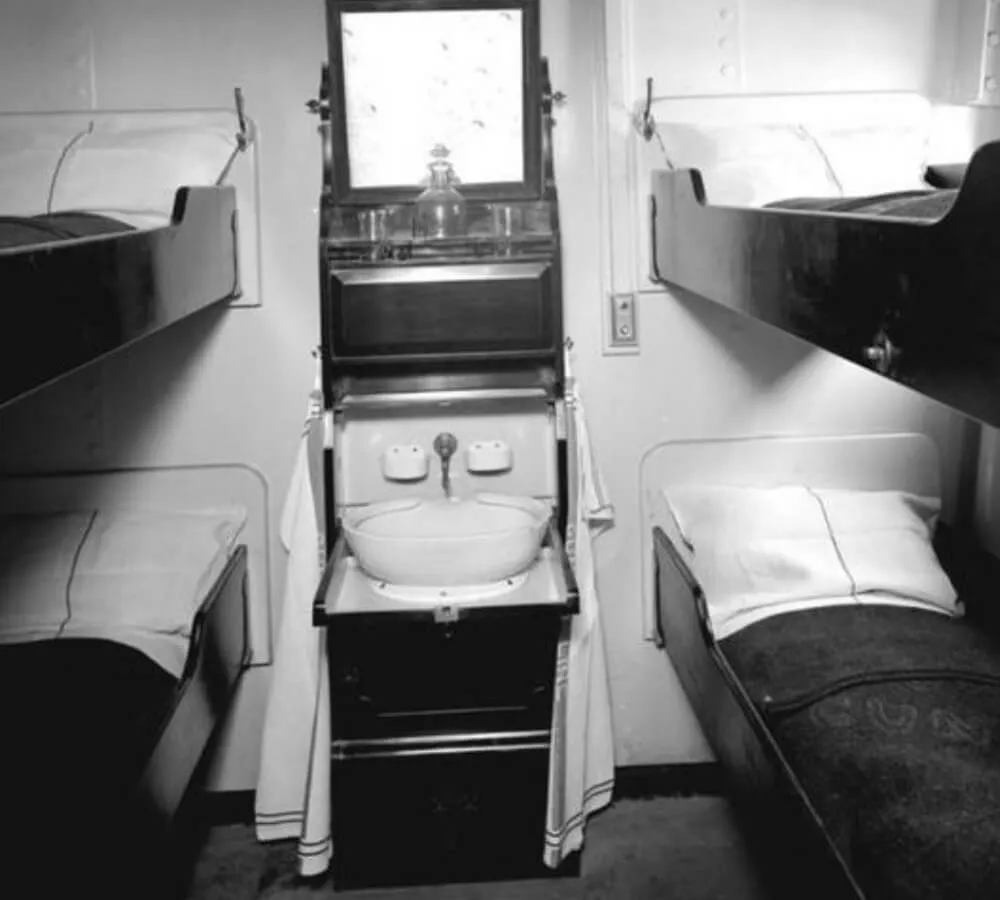
The third-class cabins were more like a jail cell than sleeping quarters. Thanks to the cramped space, most of the third class passengers spent time elsewhere on the ship. The cabins were located on F Deck and G Deck, which were some of the first to flood.
It also didn't help that the Titanic began sinking in the early hours of the morning when most third-class passengers had already gone to bed, making their escape even harder.
The Third-Class Dining Area Was More Like A Cafeteria

The third-class dining area was hardly inviting. It was more of a cafeteria-style room that left more to the imagination. Still, the silverware and table settings were likely the fanciest many third-class passengers had ever encountered. Dining with some of the finest silverware would be a highlight for many passengers who did not survive the sinking.
In the dining room, third-class passengers were served basic meals like porridge, vegetable stew, baked potatoes, and occasionally, roast beef.
The Second-Class Social Lounge Was More Than Enough

If you didn't know it, you might assume that this room was home to the first-class of passengers. No, even upholstered chairs and lavish ceilings weren't fancy enough for the first-class. Much like the first-class lounge, it was styled after the lavish Palace of Versailles, but the designer left the more ornate fixings for first-class.
This second-class social lounge was where many played cards, and some rogue third-class members would try and sneak their way into.
The Sheer Size Of The Propellers Show The Might Of The Titanic
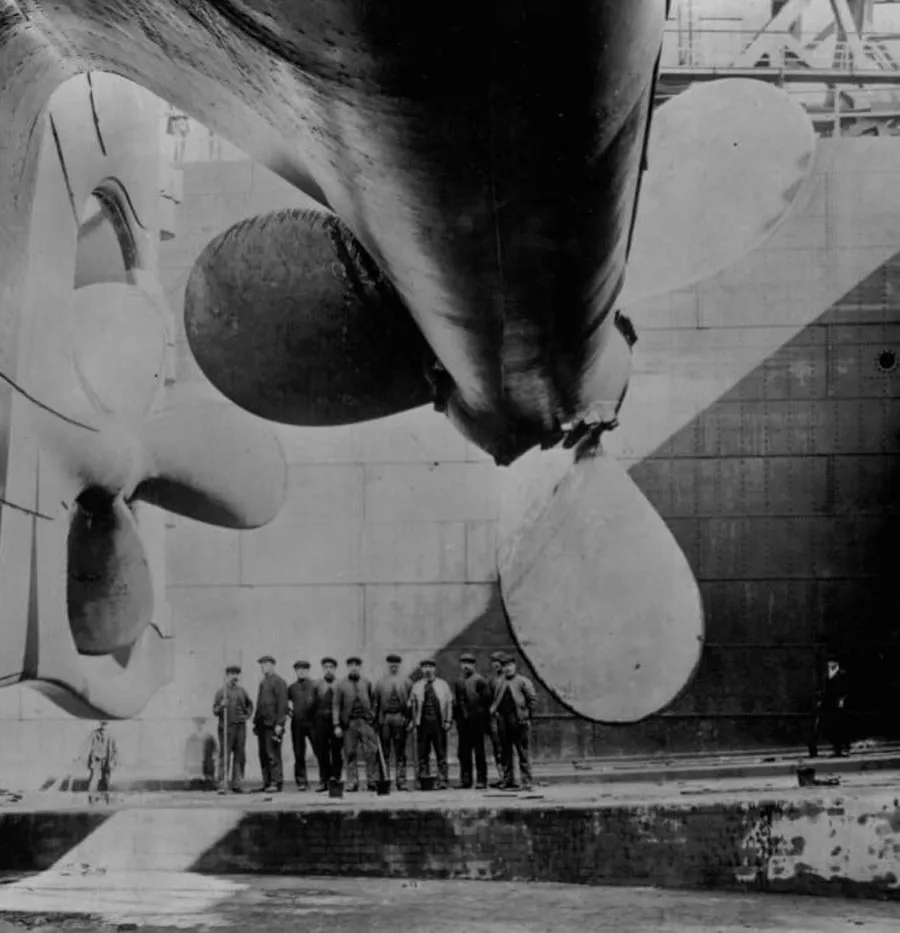
The Titanic's propellers were a staggering size. Three propellers graced the back of the Titanic, and both side propellers were 23 feet across and weighed a staggering 38 tonnes each.
With that size and weight, these propellers are actually the largest to ever be built, even larger than ones used on ships today. The people in the background show just how hefty they really were. It's hard to believe a ship with so much power could sink so quickly in the night.
The Decks Were Always Kept In Pristine Shape

There were four decks from A Deck to D Deck that were above water and could be enjoyed by the passengers. Every deck was kept in tip-top condition by the crew no matter which class inhabited them. This was because each deck was partitioned off, rather than having full separate decks for each class.
For your average third-class passenger, the attention to detail on everything, including your lower-class deck, probably made the Titanic voyage feel like a dream.
Loading Luggage On Board Was A Sight Itself

This image of a secondary ship transporting luggage onto the Titanic was one of the first taken on board. You can see some passengers watching on eagerly to see their personal belongings brought on. Little did they know, those belongings would end up in the deep depths of the ocean in just a few days.
On other ocean liners, passengers brought their own luggage on board. The Titanic revolutionized cruise ship service by employing workers to do this simple job for the passengers.
The Propellers Today Tell A Story
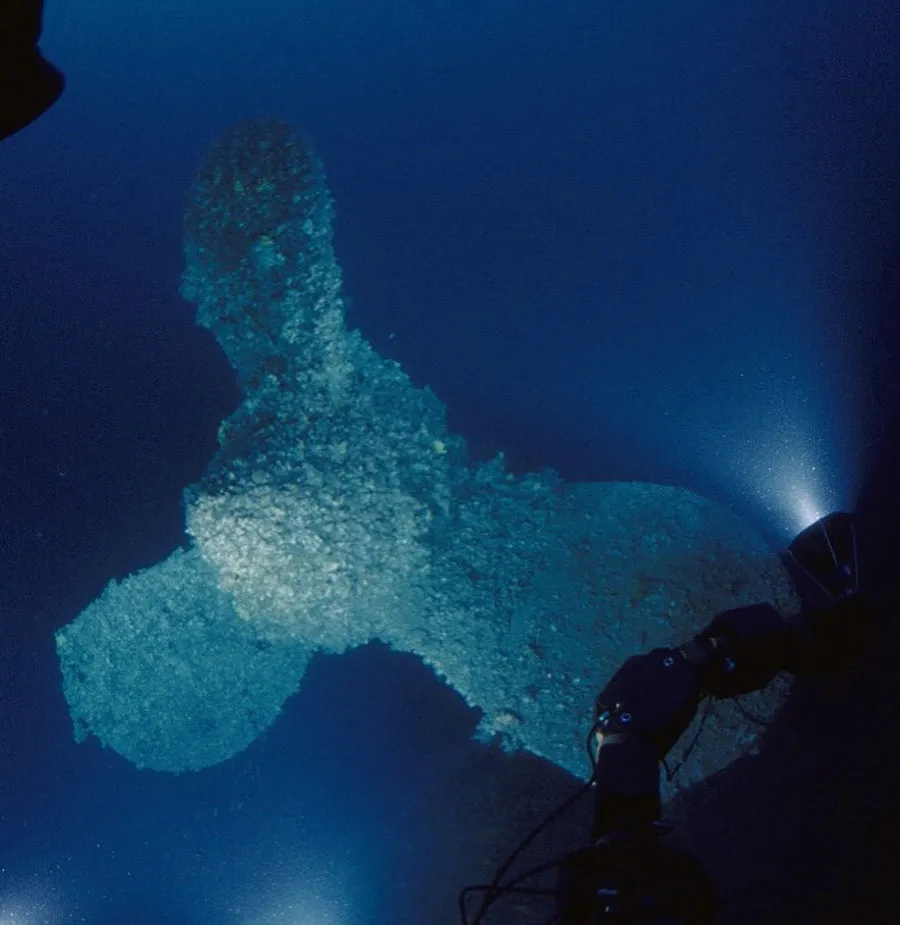
The search of the Titanic today uncovered many items left behind, but nothing was more impressive than one of those staggeringly large propellers. It has survived under the water for more than a century and with its size and shape, it is still easily recognizable.
Items like the lounge chairs, bags, and fitness equipment are nowhere to be found in the wreckage site, and ocean currents could have taken the items thousands of miles away.
The Reading Room Was A Much Needed Escape

The first-class reading and writing room seen here was built as a place for the ladies to "retreat" to following their dinner. The designer of the ship even decorated the room with pink curtains to make it feel more feminine.
After the first night of the voyage, it became clear this room was quite honestly useless. Most women remained at their dinner tables socializing when their husbands left. The designer saw it getting no use and planned to leave it out for his next ship design.
The Topmost Deck Had Quite A Breeze
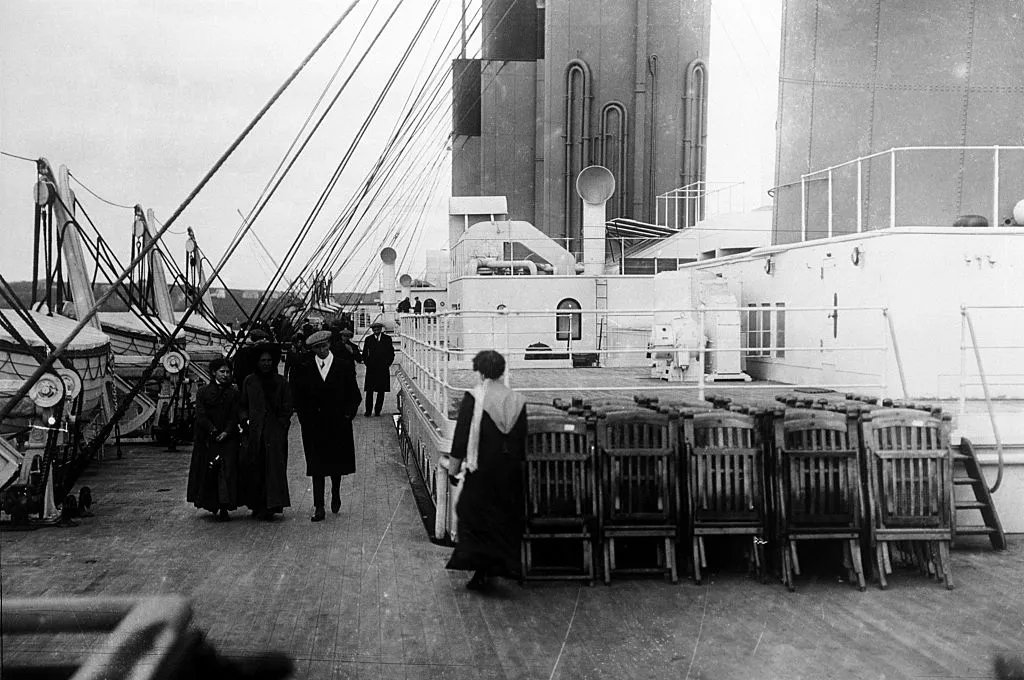
The top deck of the ship, also known as the Boat Deck because it's where the lifeboats were held, was the only deck fully open to the elements. It was segregated into four sections: for officers, for engineers, for first-class, and for second-class passengers.
Third-class passengers weren't allowed on any part of the Boat Deck. For movie nerds, that means Jack never would have been able to be "king of the world!" on the edge of the boat deck.
The Indoor Swimming Pool Was The Last Room To Flood

Despite being surrounded by water, the Titanic was one of the first ocean liners to feature a swimming pool on board. It wasn't like the pools you see on cruise ships today though. The pool was part of the gymnasium and Turkish bath complex for first-class passengers.
The pool contained salted sea water that was heated for relaxation purposes. Famously, the waterproofing of the swimming pool room meant it was the last area of the ship to flood.
Teatime Was The Social Event Of The Day
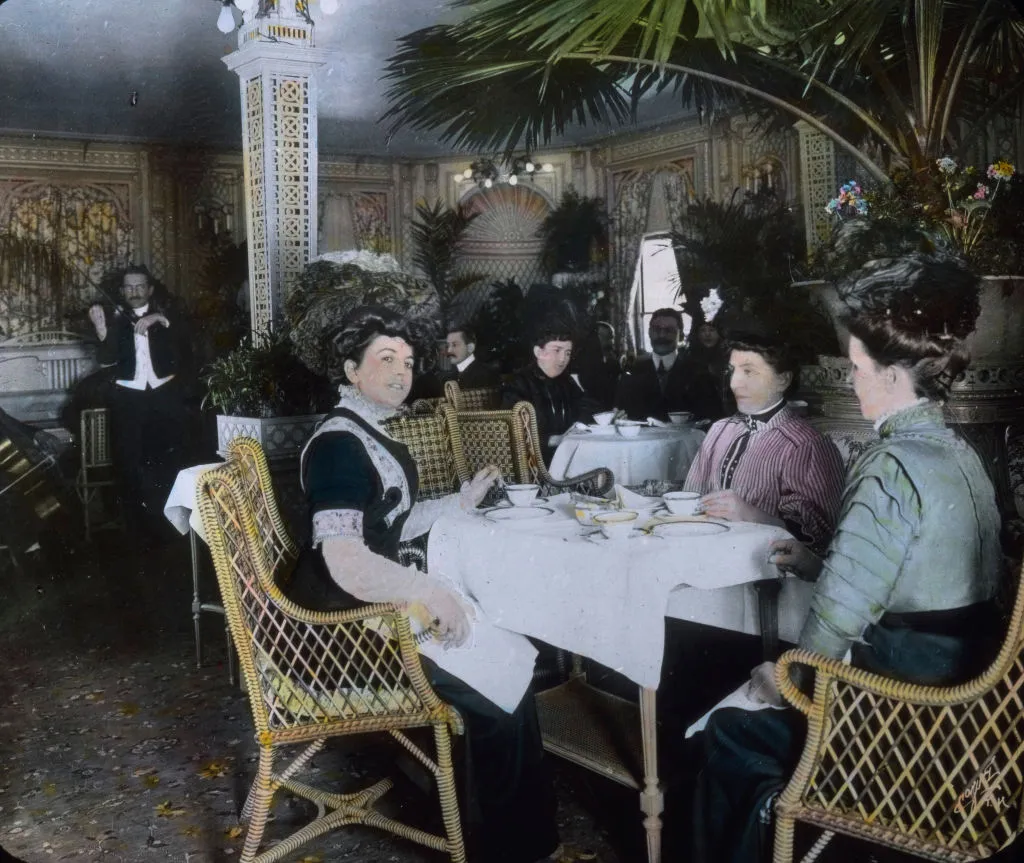
This stunning colorized photo shows ladies enjoying their afternoon tea while the band plays in the background. Buttered toast and small sandwiches were served and could tide the ladies over before dinner.
It was also one of the places onboard that served liqueurs and alcohols as early as 8 am. The first-class teatime parlor boasted a long list of liqueurs from chocolate to fruit flavors. Movie-goers would notice the room as the place where the women discuss Rose's wedding plans.
Even The Staircases Between Decks Were Lavish
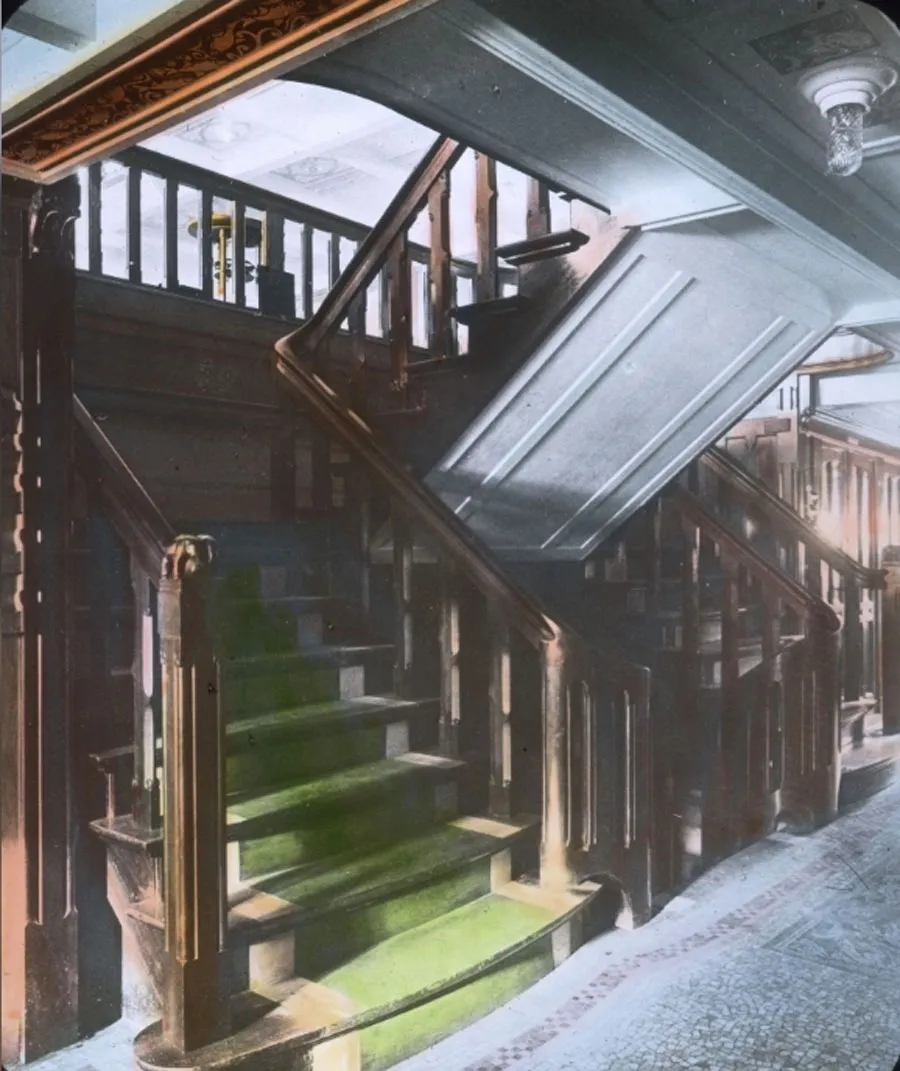
As a third-class passenger, you didn't need to visit the Grand Staircase to feel like everywhere you went was lavish. As shown here, the green velvet carpet covering dark oak staircases was a picture of wealth. Even down in the third-class decks, this is how the Titanic was decorated.
The only area of the ship that didn't lend itself to decoration was the work rooms. As soon as you stepped foot towards the boilers, it was just barren metal.
A Cross Beam Shown During The Building Of The Ship

Here, a man stands beside a massive metal cross brace that would end up running through the middle of the Titanic. Construction on the largest ocean liner began on March 31, 1909, at the shipyard seen here in Belfast.
It took 26 months from the start of construction to its launch from the shipyard. Throughout the build, approximately 3,000 men were employed. From start to finish, height men tragically died primarily by falling.
A Look At The Radio Station Aboard The Titanic

This stunning colorized photo shows a young radio operator working in the radio room aboard the Titanic. On the Titanic, there was one senior radio operator, Jack Phillips, who worked during the day and took time off at night. He woke up as the ship was sinking and did send out distress signals to ships up until his final minutes.
After the sinking of the Titanic, laws were enacted that made it mandatory to have a rotating radio crew on ships so that there was always someone awake and attentive to send for help.
Lifeboats On The Top Deck Of The Titanic

It is well known today that even though some lifeboats left the Titanic only half full, even at their capacity there would not have been enough to save everyone on board. There were only 20 lifeboats onboard which meant of the 2,220 passengers and crew only 1,100 would have been able to survive.
The lifeboat launcher was also proven in the disaster to be slow and often faulty. Many of the crew didn't even have training on how to launch a lifeboat.
Survivors Of The Titanic Approach The Carpathia

The first lifeboat was launched from the Titanic at 11:45 p.m. and they continued to launch until the ship capsized at 2:15 a.m. It was not until two hours later around 4 a.m. that the first lifeboat would reach the RMS Carpathia. The Carpathia rescued the final group of lifeboats at 8:30 a.m.
You can see in this photo that the lifeboat if being rowed by mostly women, which was not surprising as women and children were loaded on first.
Survivors Try To Warm Up On Deck Of The Carpathia

Here, survivors rescued from the lifeboats rest in the sun on the top deck of the RMS Carpathia. The ship was actually sailing eastward from New York when the radio operator received distress messages from the Titanic. The ships' captain immediately set course for the Titanic and arrived two hours after the ship had sunk.
Thanks to the ship and crew's rescue efforts, 712 people were saved and safely transported to their original destination, New York City.
The Carpathia's Crew Was Honored Greatly

Thanks to their selfless work in saving the Titanic survivors, the captain and crew members of the Carpathia were honored greatly. Captain Arthur Rostron and his senior crew are shown here sitting with a silver cup that was presented to them by survivors of the Titanic.
Captain Rostron later went on to be an honored guest of President Taft at the White House. There, he was presented with the Congressional Gold Medal, which is the highest honor possible.
They Saved The Lifeboats

At the time, the thirteen lifeboats that the Carpathia chose to save and board onto their ship were the only remains of the Titanic. The Carpathia brought the lifeboats back to New York where they intended to return them to the White Star Line.
Unfortunately, the lifeboats seen in wait here at Pier 59 were quickly stripped by looters and souvenir hunters. Over time, the lifeboats have been lost to history. Most people think they were either reused on other White Star Line ships, or quietly destroyed.
People Around The World Raised Funds For The Victims
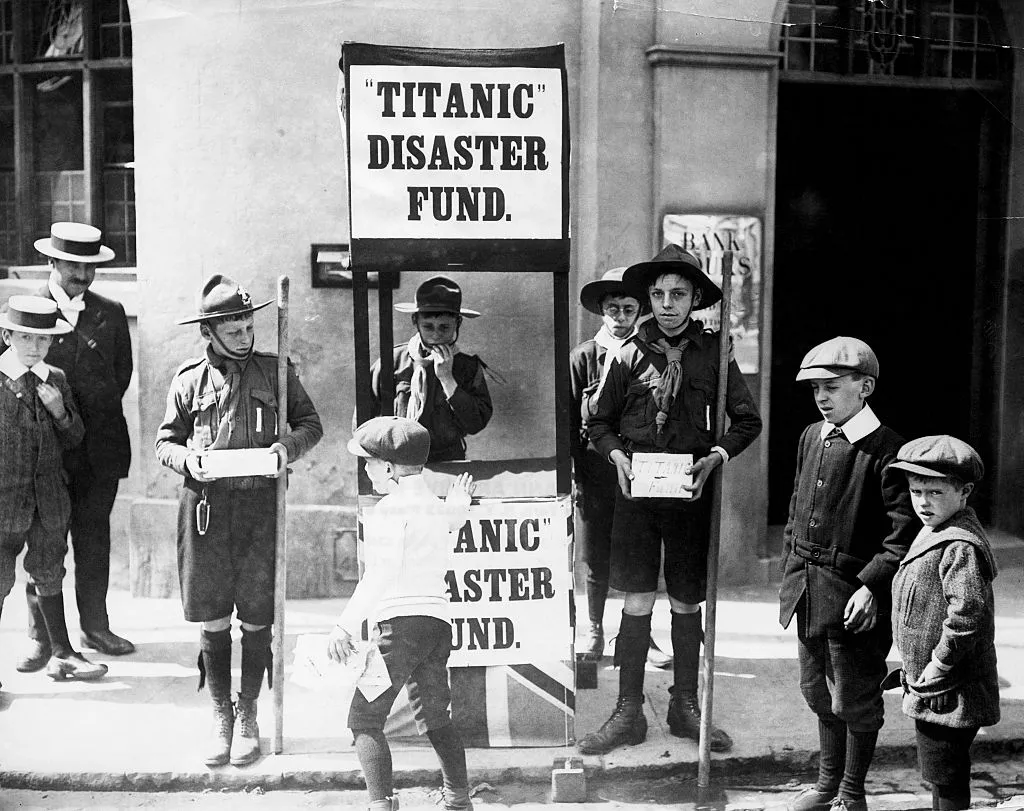
The after-effects of the Titanic's sinking wasn't just felt in England and America. The news was heard around the world and there seemed to be passengers on board from all corners of the globe.
Here, a boy scout troop in Stratford raise funds for Titanic survivors but they were not the only ones. The White Star Company which owned and built the Titanic set up a relief fund that paid thousands to the victim's families and to the survivors.
Survivors Find Refuge In New York City

Upon arrival in New York City, many survivors were left begging for help from sympathizers. While some were lucky enough to have friends or family in the city, others had to wait for financial aid to come in.
These men sit here in a makeshift shelter while they wait to receive help. Thankfully, once the shock mulled over, many in New York were sympathetic to the survivors and opened their homes to them while they waited.
A Woman Buys A Titanic Print

It didn't take long after news hit about the disaster that people began looking for ways to capitalize on the tragedy. Street markets and entrepreneurs began selling everything from figurines, postcards, and newspapers for inflated prices. Here, a woman buys a print of the Titanic not long after hearing the news.
Some were even desperate enough to loot the lifeboats. It likely paid off in their favor though as Titanic memorabilia has only increased in value.
Crowds Gather To Welcome Survivors Back To Britain
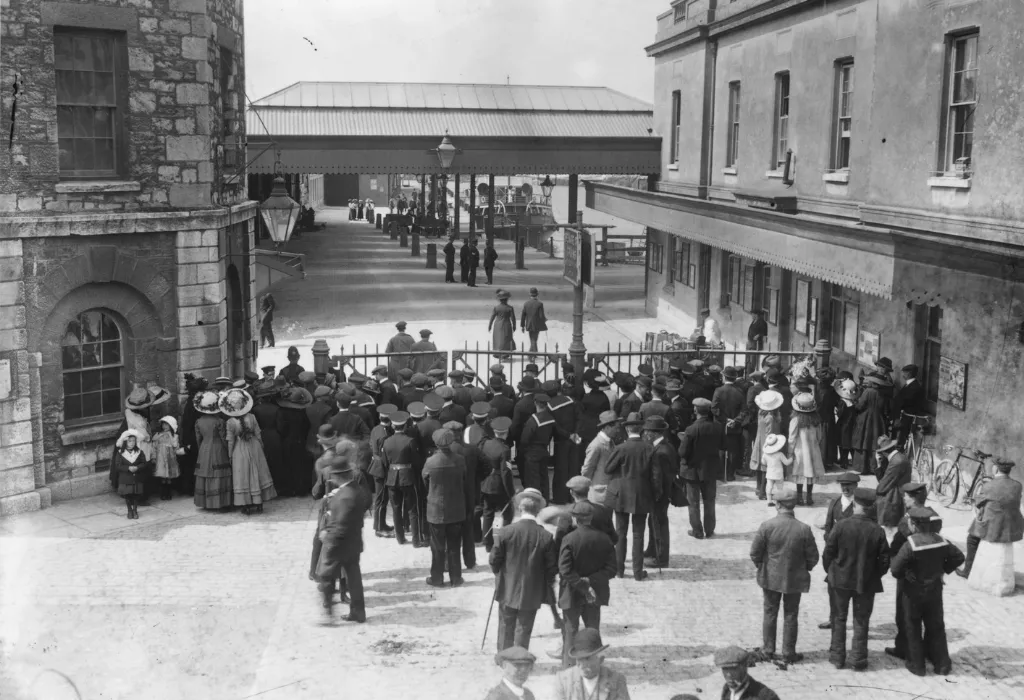
Men, women, and children gather around the gates at the Belfast shipyard. They were anxiously awaiting the RMS Lapland to dock. The Lapland was transporting 172 Titanic survivors back across the Atlantic ocean to return home.
The crowd in Belfast was nothing in comparison to the original crowds in New York City. Tens of thousands of New Yorkers gathered along the pier on April 18, 1912, to catch a glimpse of the Carpathia and the survivors.
A Man Testifies In Front Of The Inquiry Committee

It didn't take long for the public grief to turn into anger and outrage. Many quickly began to wonder how an ocean liner that was supposed to be unsinkable managed to capsize on its maiden voyage. Before the Carpathia even docked in New York, White Star Line had already begun to assemble an inquiry committee.
The committee concluded that the combined failure to listen to the iceberg warnings as well as the inadequate lifeboats was why the disaster took so many lives.
Surviving Crew Members Wait Outside The Courthouse

Here, crew members who survived the disaster wait patiently outside a courthouse while the White Star Line inquiry committee debates inside. Many survivors expected financial compensation for the ordeal.
In the end, White Star Line settled out of court with the survivors and agreed to pay out $664,000 to be split between the survivors. With more than 700 people, that worked out to around $950 per person. Adjusted for inflation, each survivor received just over $22,000.
Two Young Survivors Wait To Be Reunited With Their Mother
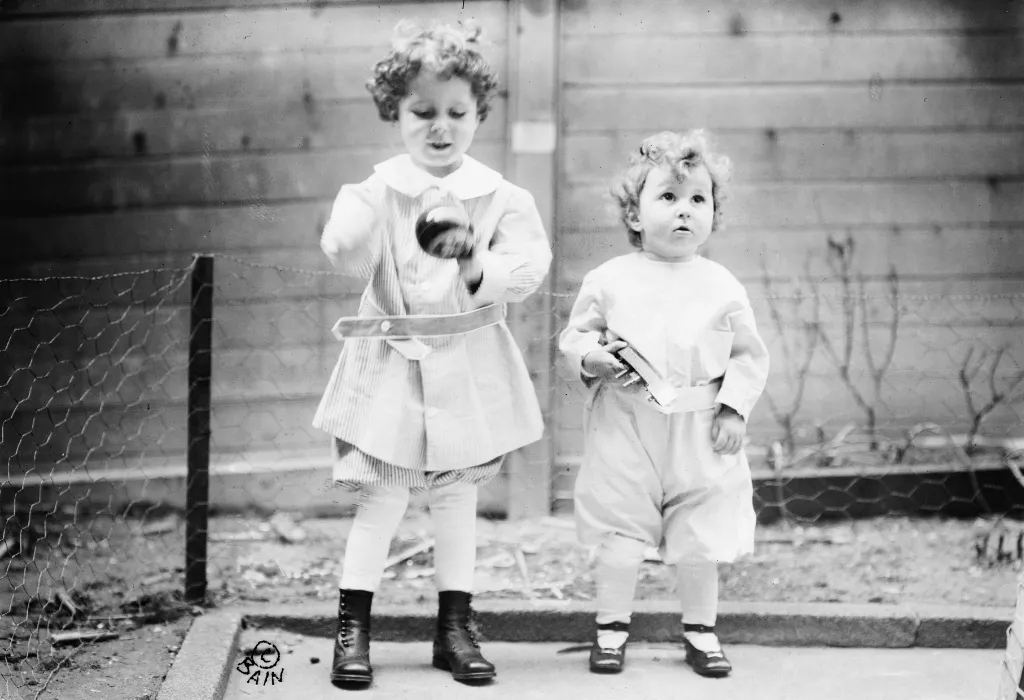
Even though they were the first in the lifeboats, sixty children did not survive the sinking of the Titanic. Two who did, Michel and Edmond Navratil, are seen here safely in New York. Sadly, their father drowned in the ocean after placing his two sons in the lifeboat.
The Navratil boys traveled second-class with their father while their mother stayed behind in France. It took weeks for them to finally be reunited but they are considered one of the Titanic success stories.
Milton Hershey's Last Minute Cancellation

In December 1911, Milton S. Hershey, founder of the Hershey Chocolate Company, put down a deposit for a VIP stateroom aboard the Titanic. The deposit cost $300, equivalent to an estimated $7,281 today. Hershey decided to take his wife on a trip to Nice, France and bought the VIP tickets for the Titanic for their return trip home.
Not long before the Titanic set sail, Hershey canceled his ticket and boarded an earlier ship back to the U.S. The reason for the cancelation is still unknown. The check for the deposit, made out to White Star Lines, is in the Hershey Community Archives.
A Rescue Ship Ignored the Distress Signals
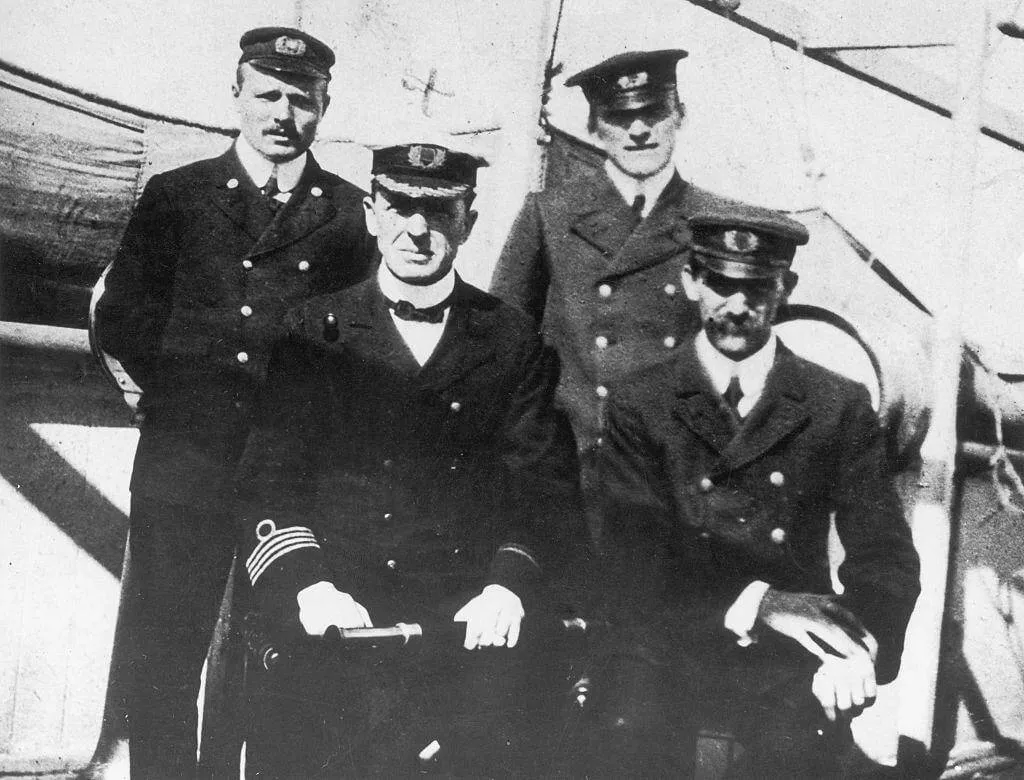
While the Carpathia eventually came to rescue the survivors of the Titanic, there was, in fact, another ship closer to the wreck, the S.S. California, that did absolutely nothing. The ship's captain, Stanley Lord, apparently became aware of the Titanic sinking after officers on the ship saw the flare signals. Yet he did not order his vessel to assist the sinking ship.
The captain and crew were investigated after the fact, and many of their accounts were confusing and inconsistent. The backlogs of that night managed to disappear. Captain Lord was fired and forever disgraced.
Immortalized Words
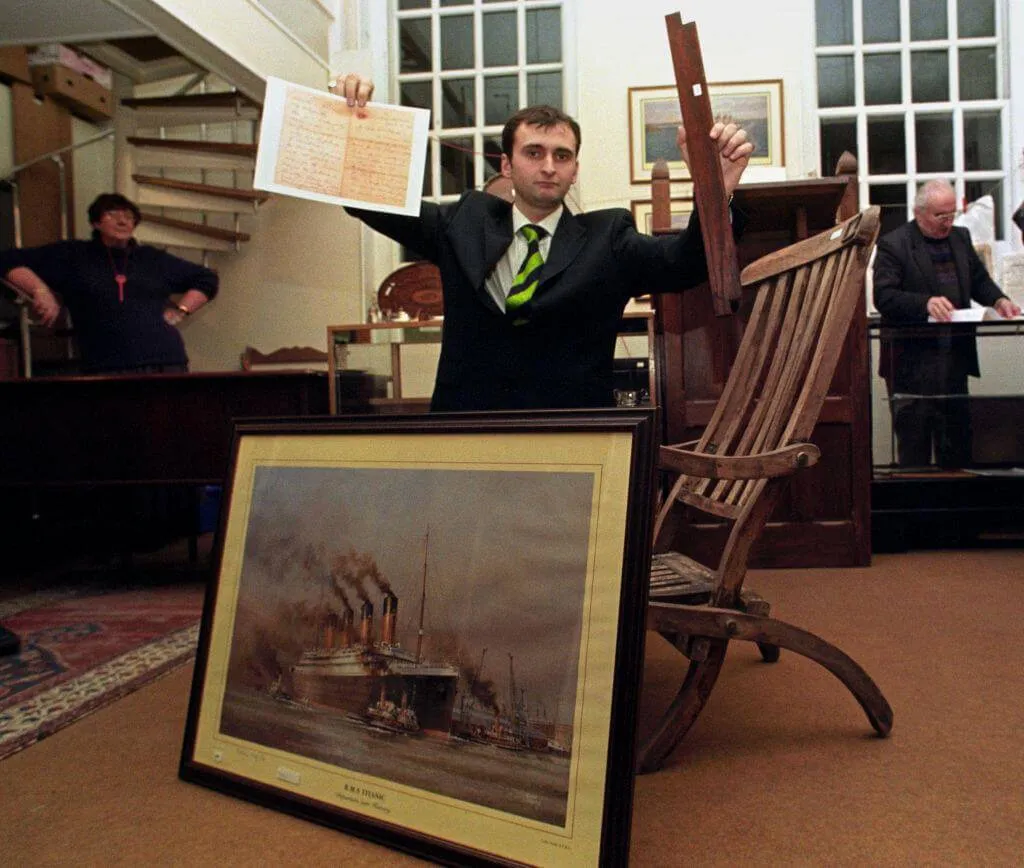
Just a few hours before the Titanic hit an iceberg, a passenger named Esther Hart wrote a letter to her mother in England. The letter was penned in the Titanic's library on the ship's signature stationery. It talked about the wonderful journey she, her husband, and her seven-year-old daughter, Eva, were having aboard the ship. Her husband, unfortunately, passed, while Eva and Esther survived.
The letter has weathered the past 100 years, kept in the family as a memento. In 2016 it went up for auction in England and sold to an American bidder for $18,000.
Victims Lost At Sea

Out of the 1,503 lives that were lost when the Titanic sank, only 340 bodies were recovered, found floating in their life jackets in the days after the shipwreck. But what happened to the remaining 1,163 victims is still a mystery to this day. No remains have been found at the wreckage site.
There are a few theories circulating about these missing remains. Some experts say that a storm spread the floating victims out in a 50-mile-wide area, and their bodies are most likely scattered along the ocean floor. Others believe that bodies were trapped inside and thus heavily decomposed and attacked by sea scavengers.
Only Three Smoke Stacks Were Functioning
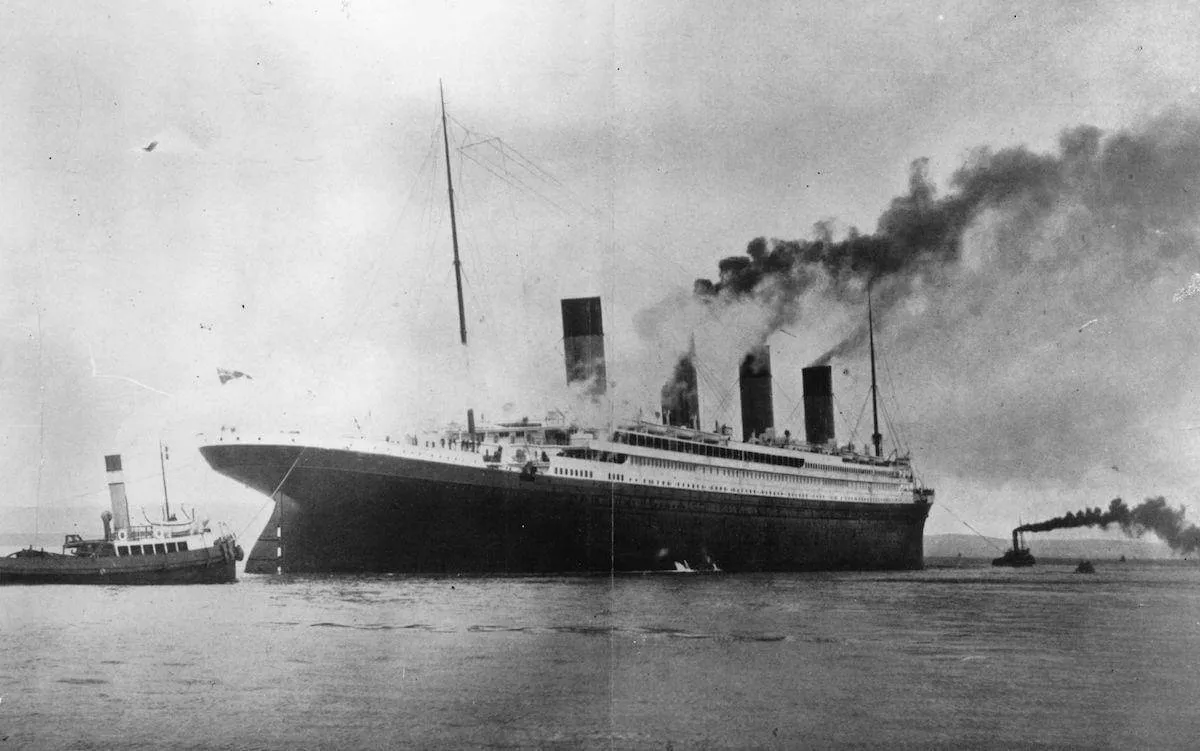
Photos of Titanic depict four giant smokestacks towering on top of the ship. Three drew smoke and heat from the furnaces of the 29 boilers. The fourth wasn't connected to the furnace; it was a dummy stack to make the ship look more impressive
During the 1900s, the number of funnels a liner had was considered a symbol of speed and safety, and the Titanic was meant to be the best of the best. Also, if there were only three, they'd have been placed towards the front of the ship. By having four, they could be spread out equally, making it appear more balanced.
A Psychic Predicted The Tragedy

Twenty-four-year-old Alice Elizabeth Fortune, her parents, sisters, and brother were first-class passengers aboard Titanic. They were returning back home in Canada after a European vacation. During their visit to Cairo, Egypt, two months prior, Alice went to see a fortune teller.
The psychic told her that every time she traveled by sea, she would be in danger and that she could actually see Alice adrift in the open water. She was told she'd lose everything but her life. Alice, her mother and sisters were rescued from the Titanic, but her brother and father died in the wreck.
Alcohol May Have Saved One Man's Life
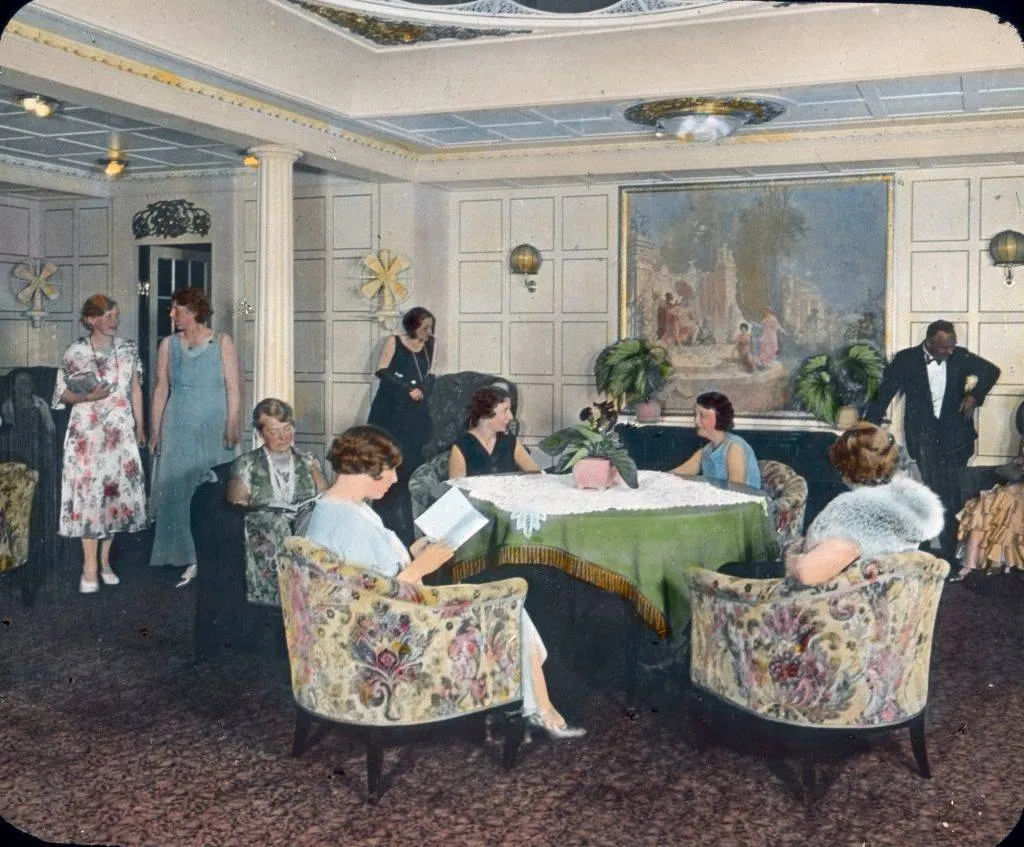
As the Titanic sank into the sea, Charles Joughin, the chief baker on the ship, nonchalantly stepped off the stern into the freezing waters and began paddling around until dawn, when he was rescued by a lifeboat. While others froze to death, Charles survived.
The reason he was able to withstand the ice cold temperatures for so long was attributed to the generous amount of alcohol he had drunk, which kept his organs fortified until he was rescued. Before he got too drunk, he managed to ensure that all of the lifeboats were filled with bread and biscuits.
Animals On Board

There were a number of animals aboard the Titanic, including dogs, cats, chickens, birds, and rats. There was even an "official" Titanic cat named Jerry, who helped keep the rats at bay. She and her kittens lived in the galley.
The only animals to survive the wreck were three of the twelve dogs brought on board because they were lucky enough to make it on a lifeboat. Two of the dogs were Pomeranians and one was a Pekinese, and no one seemed to mind squeezing them on the boats. One of the dogs belonged to Henry Harper, heir to Harper & Row publishing.
The First Victim Never Set Sail

Samuel Joseph Scott was one of 15,000 workers who built the Titanic and her sister ship, Olympic, in Ireland. He was only 15 years old and earned between $5 to $10 a week. On April 20, 1910, while working on the ship, Samuel slipped off of a ladder into the open hull. He fractured his skull and died.
In 2011, Samuel was finally given a headstone, which was unveiled during a ceremony that was attended by the niece and the nephew of the Titanic's designer. His epitaph includes the following words: "Remembering his soul and all those who perished in the sinking of the Titanic."
The Iceberg Was From 1000 BC

The iceberg that sunk the Titanic began its voyage to the North Atlantic over three thousand years ago, around 1000 BC. It is speculated that it all began with snowfall on the western coast of Greenland, which compacted over the span of a few months. In the proceeding decades, it became more compact from the weight of more falling snow, forming into dense ice.
Frozen waters pushed it westward, and chunks were broken off, or calved, and pushed south. Most icebergs only last a few years after they are calved, so experts believe it floated away from Greenland around 1910.
The Second Ocean Liner to Ever Have a Pool

At the time it was built, the Titanic was considered the most luxurious ship ever made. It was the second liner ever to have a swimming pool on board. The first was its sister ship, Olympic, which set sail the year prior. But the Titanic's pool was larger, measuring at 30 by 14 feet, and was also heated, while the Olympic's was not.
The pool, then called a swimming bath, was for first-class passengers only. It was filled with sea water, but of course was a lot warmer than the 28-degree temperatures in the ocean.
The Captain Crashed A Ship The Year Before

There are mixed feeling regarding the Titanic's Captain, Edward John Smith. Some think his negligence led to one of the worst disasters in history, while others believe he was a hero for courageously going down with his ship. Coincidentally, the Titanic was not his first mishap as a captain.
The year prior, Smith had been the Captain of the Olympicwhen it collided with a British warship. Despite major damage, the ship made it safely back to shore but suffered extremely costly damage. The Royal Navy blamed the Olympic for the accident, claiming that its massive size caused a suction that pulled the warship into it.
Putting On The Ritz

The interior of the Titanic was extremely lavish, complete with dining rooms with ornate ceilings and plush carpets. It was designed to resemble the Ritz Hotel in London. The first class cabins were also very similar to some of the high-end suites at the Ritz.
There was even a restaurant on B deck called The Ritz Restaurant. The restaurant was for first-class passengers only and was considered an "Optional Extra", with extremely high prices. The tables were always fully booked up by the rich and famous.
It Cost What?!

The Titanic cost $7.2 million to build, equivalent to $180 million today. So it's no surprise that first-class tickets came with a hefty price tag, which is why it was filled with millionaires. Charlotte Drake Cardeza, a 58-year-old daughter of a wealthy textile-mill owner, may not have been the wealthiest person onboard, but she purchased the most expensive ticket.
Cardeza’s first-class parlor ticket cost $4,350 which is equivalent to $69,600 today. Her room had two bedrooms, a sitting room, two wardrobe rooms and a bath. She was traveling with her 36-year-old son, her maid, his valet and 14 trunks, four suitcases, and three crates.
See It With Your Own Eyes

Expeditions to the site ceased in 2012, but as of May 2018, tourists will again be able to visit the wreck. A London-based travel company called Blue Marble Private will provide guided eight-day tours, which will begin in Newfoundland, Canada. Voyagers will board a submersible that'll take them to the Titanic two miles below the surface. The experience will cost $105,129 per person, and the first trip is already completely booked.
The time to visit the Titanic may be limited, as a study conducted in 2016 claimed that "extremophile bacteria" may very well eat away what’s left of the wreck within the next 15-20 years.
A Drill Was Canceled The Day It Sunk

During the 1900s, lifeboat drills were regularly conducted on ocean liners in order to prep the crew and passengers on what to do in the case of an emergency. In fact, there was a drill scheduled aboard the Titanic on the morning of April 14th, but Captain Edward John Smith canceled it for some unknown reason. Later that day, the Titanic struck an iceberg.
Hysteria ensued, and without the experience of running the drill, there was lots of confusion on how to properly utilize the lifeboats. A large number of them set off only half full, leading to a greater loss of life than was necessary.
Third Class Life

Third- class accommodations on the Titanic, known as steerage, were designed to hold two to six passengers. They were grouped by family or gender and were primarily immigrants moving to the United States and Canada. When adjusted to today's standard, tickets cost approximately $700 for adults and $300 for children.
Before stepping on the ship, all steerage passengers were given a health inspection to check for disease, lice, and other infections. They slept in bunk beds that had mattresses, pillows, and blankets, but no sheets or pillowcases. There were over 700 people in steerage, and they all had to share two bathtubs. Luckily, they had flushing toilets.
And The Band Played On

Panic set in aboard the Titanic as it began to sink. The ship's eight-member band gathered in the first-class lounge and began to play in an effort to keep everyone calm. As the ship sank further, the band, led by Wallace Hartley, played on, with no consideration of saving their own lives.
There's been much debate on what was the final song that they played. One survivor claimed that "Nearer, My God, to Thee" was the last song, but she apparently left on a lifeboat 20 minutes before it completely sank. A wireless operator reported that he had heard the song “Autumn” being played as the ship submerged.
Daily News

Each night during the First Watch, a Marconi operator would copy down the Marconi news service broadcast, and then type it all out. He'd also include some other information, like daily menus, society gossip (which included such "news" as what first-class passengers wore to dinner the previous night), add in some advertisements, then print it all through a mini printing press that was located in the Chief Pursers Office.
These write-ups became a daily newspaper for the Titanic, called the Atlantic Daily Bulletin. The bulletin was then posted each night in the first-class smoking room.









